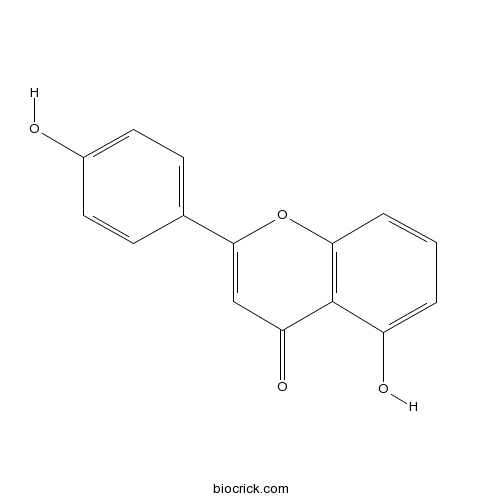4',5-DihydroxyflavoneCAS# 6665-67-4 |

Quality Control & MSDS
3D structure
Package In Stock
Number of papers citing our products

| Cas No. | 6665-67-4 | SDF | Download SDF |
| PubChem ID | 165521 | Appearance | Yellow powder |
| Formula | C15H10O4 | M.Wt | 254.2 |
| Type of Compound | Flavonoids | Storage | Desiccate at -20°C |
| Solubility | Soluble in Chloroform,Dichloromethane,Ethyl Acetate,DMSO,Acetone,etc. | ||
| Chemical Name | 5-hydroxy-2-(4-hydroxyphenyl)chromen-4-one | ||
| SMILES | C1=CC2=C(C(=C1)O)C(=O)C=C(O2)C3=CC=C(C=C3)O | ||
| Standard InChIKey | OKRNDQLCMXUCGG-UHFFFAOYSA-N | ||
| General tips | For obtaining a higher solubility , please warm the tube at 37 ℃ and shake it in the ultrasonic bath for a while.Stock solution can be stored below -20℃ for several months. We recommend that you prepare and use the solution on the same day. However, if the test schedule requires, the stock solutions can be prepared in advance, and the stock solution must be sealed and stored below -20℃. In general, the stock solution can be kept for several months. Before use, we recommend that you leave the vial at room temperature for at least an hour before opening it. |
||
| About Packaging | 1. The packaging of the product may be reversed during transportation, cause the high purity compounds to adhere to the neck or cap of the vial.Take the vail out of its packaging and shake gently until the compounds fall to the bottom of the vial. 2. For liquid products, please centrifuge at 500xg to gather the liquid to the bottom of the vial. 3. Try to avoid loss or contamination during the experiment. |
||
| Shipping Condition | Packaging according to customer requirements(5mg, 10mg, 20mg and more). Ship via FedEx, DHL, UPS, EMS or other couriers with RT, or blue ice upon request. | ||
| Description | 4',5-Dihydroxyflavone is a soybean LOX-1 and yeast α-Glucosidase inhibitor, with an Ki of 102.6 μM for soybean LOX-1 and an IC50 of 66 μM for yeast α-glucosidase. |
| Targets | LOX |
| Structure Identification | J Agric Food Chem. 2005 May 18;53(10):4258-63.Human gut microbial degradation of flavonoids: structure-function relationships.[Pubmed: 15884869]
|

4',5-Dihydroxyflavone Dilution Calculator

4',5-Dihydroxyflavone Molarity Calculator
| 1 mg | 5 mg | 10 mg | 20 mg | 25 mg | |
| 1 mM | 3.9339 mL | 19.6696 mL | 39.3391 mL | 78.6782 mL | 98.3478 mL |
| 5 mM | 0.7868 mL | 3.9339 mL | 7.8678 mL | 15.7356 mL | 19.6696 mL |
| 10 mM | 0.3934 mL | 1.967 mL | 3.9339 mL | 7.8678 mL | 9.8348 mL |
| 50 mM | 0.0787 mL | 0.3934 mL | 0.7868 mL | 1.5736 mL | 1.967 mL |
| 100 mM | 0.0393 mL | 0.1967 mL | 0.3934 mL | 0.7868 mL | 0.9835 mL |
| * Note: If you are in the process of experiment, it's necessary to make the dilution ratios of the samples. The dilution data above is only for reference. Normally, it's can get a better solubility within lower of Concentrations. | |||||

Calcutta University

University of Minnesota

University of Maryland School of Medicine

University of Illinois at Chicago

The Ohio State University

University of Zurich

Harvard University

Colorado State University

Auburn University

Yale University

Worcester Polytechnic Institute

Washington State University

Stanford University

University of Leipzig

Universidade da Beira Interior

The Institute of Cancer Research

Heidelberg University

University of Amsterdam

University of Auckland

TsingHua University

The University of Michigan

Miami University

DRURY University

Jilin University

Fudan University

Wuhan University

Sun Yat-sen University

Universite de Paris

Deemed University

Auckland University

The University of Tokyo

Korea University
- Ethyl caffeate
Catalog No.:BCN4214
CAS No.:102-37-4
- N-p-Coumaroyloctopamine
Catalog No.:BCN4603
CAS No.:66648-45-1
- N-Feruloyloctopamine
Catalog No.:BCN4604
CAS No.:66648-44-0
- N-trans-Feruloyltyramine
Catalog No.:BCN4213
CAS No.:66648-43-9
- Acetyl Angiotensinogen (1-14), porcine
Catalog No.:BCC1023
CAS No.:66641-26-7
- Biotin Hydrazide
Catalog No.:BCC3582
CAS No.:66640-86-6
- GW842166X
Catalog No.:BCC4413
CAS No.:666260-75-9
- 2',4'-Dihydroxy-3,7':4,8'-diepoxylign-7-ene
Catalog No.:BCN6645
CAS No.:666250-52-8
- Risperidone mesylate
Catalog No.:BCC4206
CAS No.:666179-96-0
- Risperidone hydrochloride
Catalog No.:BCC4205
CAS No.:666179-74-4
- RU 24969
Catalog No.:BCC5423
CAS No.:66611-26-5
- Boc-Phenylalaninol
Catalog No.:BCC2718
CAS No.:66605-57-0
- Galangin 3-methyl ether
Catalog No.:BCN3681
CAS No.:6665-74-3
- 5,7-Diacetoxyflavone
Catalog No.:BCN4216
CAS No.:6665-78-7
- 7-Hydroxyflavone
Catalog No.:BCN3673
CAS No.:6665-86-7
- Esculentoside H
Catalog No.:BCN2795
CAS No.:66656-92-6
- Platycodin D2
Catalog No.:BCN3847
CAS No.:66663-90-9
- Polygalacin D
Catalog No.:BCN3861
CAS No.:66663-91-0
- 8-Bromo-7-(but-2-yn-1-yl)-3-methyl-1H-purine-2,6(3H,7H)-dione
Catalog No.:BCC8786
CAS No.:666816-98-4
- E-64
Catalog No.:BCC1222
CAS No.:66701-25-5
- 3-Nitro-L-tyrosine ethyl ester hydrochloride
Catalog No.:BCN1384
CAS No.:66737-54-0
- DBU
Catalog No.:BCC2840
CAS No.:6674-22-2
- 5-Hydroxy-7-acetoxyflavone
Catalog No.:BCN4217
CAS No.:6674-40-4
- PG 931
Catalog No.:BCC6363
CAS No.:667430-81-1
Human gut microbial degradation of flavonoids: structure-function relationships.[Pubmed:15884869]
J Agric Food Chem. 2005 May 18;53(10):4258-63.
The relationship between chemical structure and gut microbial degradation rates of 14 flavonoids, flavone, apigenin, chrysin, naringenin, kaempferol, genistein, daidzein, daidzin, puerarin, 7,4'-dihydroxyflavone, 6,4'-dihydroxyflavone, 5,4'-dihydroxyflavone, 5,3'-dihydroxyflavone, and 4'-hydroxyflavone, was investigated by anaerobically fermenting the flavonoids with human gut microflora (n = 11 subjects). Degradation rates for the 5,7,4'-trihydroxyl flavonoids, apigenin, genistein, naringenin, and kaempferol, were significantly faster than the other structural motifs. Puerarin was resistant to degradation by the gut microflora. Extensive degradation of flavonoids by gut microflora may result in lower overall bioavailability than those flavonoids that are slowly degraded because rapidly degrading flavonoids are less likely to be absorbed intact.


